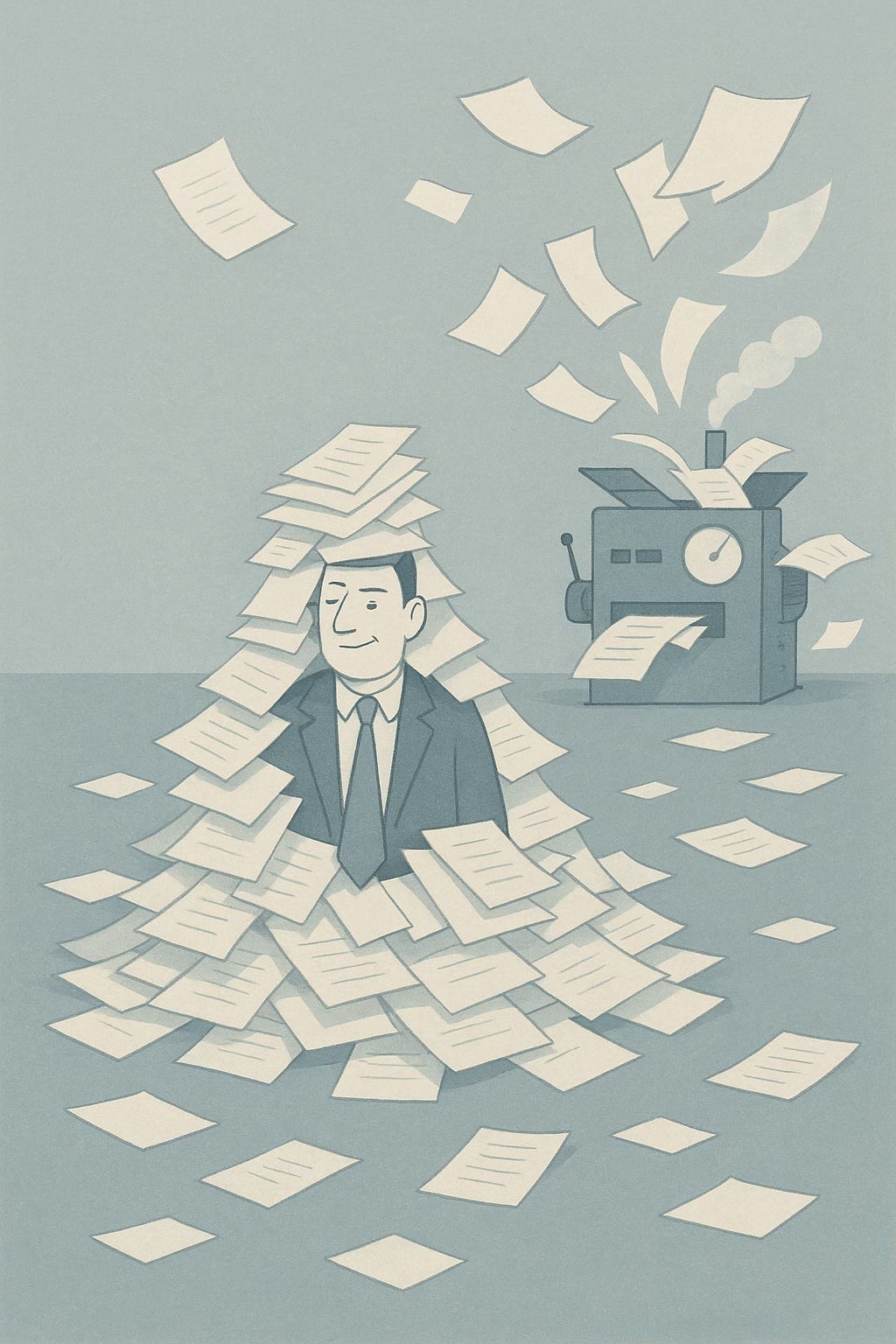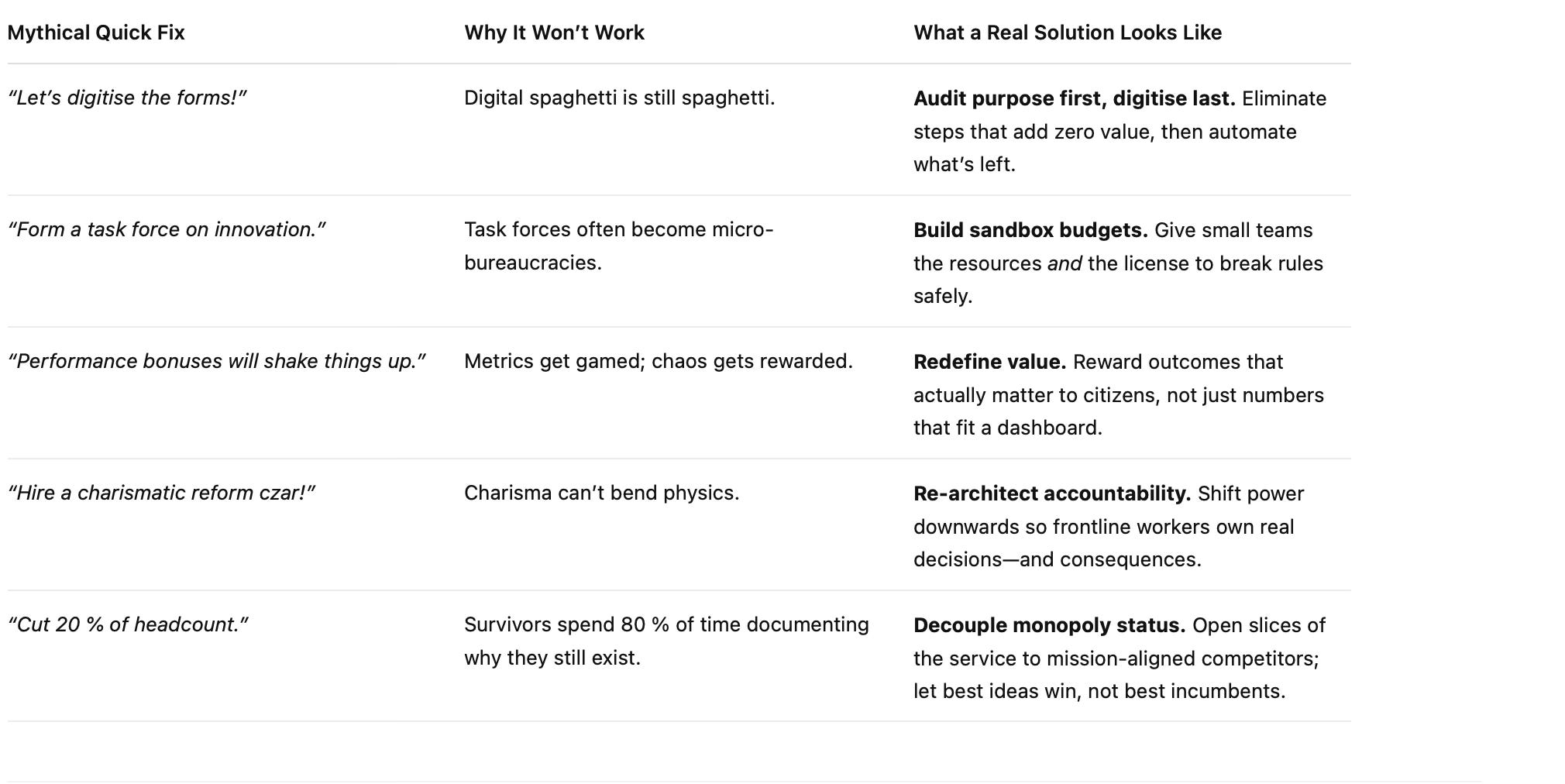Paperwork: Humanity’s Funniest Apocalypse
“From Clockwork to Clown Car: Why Bureaucracy’s Quest for Perfect Order Ends in Total Mayhem”
Remember the first time you saw a class timetable? Blocky rows. Colour-coded cells. Bell rings every 50 minutes. It looked reassuringly precise—like someone had translated Swiss-made watches into paper form. ✨ Spoiler: that timetable is the larval stage of a beast that eventually grows six heads, 42 sub-committees, and a filing cabinet nobody has opened since the Spice Girls were still together. Bureaucracy starts out promising order; it finishes by throwing confetti made of your lost afternoons and everybody’s sanity.
The Grand Paradox: Order → Paperwork → Entropy
Orderly Intent
Bureaucracy is born from a noble urge: “If we write down the rules, chaos will never sneak in.”
Procedural Creep
Every exception spawns a new clause. Clause #47(b)(iii) addresses “What if the stapler jams during the fire drill?” Layers pile on layers until the rules resemble a Russian nesting doll that refuses to stop nesting.
Operational Paralysis
Decisions slow to geological time. By the moment you get approval to innovate, the disruptive idea has already been commercialised by four start-ups, trademarked, and turned into a Netflix limited series.
Emergent Chaos
Ironically, the quest for microscopic control creates a sprawling, unmanageable landscape. Your “strictly regulated” system now leaks money, talent, and data faster than you can convene yet another steering group. Order folds in on itself and becomes a black hole of calendar invites.
Passenger Mode 2.0: Survival in The Clown Car
Kids absorb this contradiction early. Realising the rules are both omnipresent and mutually contradictory, most choose the safest coping strategy: Permanent Low-Fidelity Compliance—a.k.a. “smile, nod, and produce just enough output to stay off the radar.” That habit calcifies when they join large public or third-sector bodies:
Metric Jenga – adding yet another performance indicator until the tower wobbles uncontrollably.
Zombie Projects – killed at last month’s meeting, but somehow still shuffle to life on next month’s budget spreadsheet.
Chaos Delegation – if the workflow is incomprehensible, pass it to another department and hope the email thread ages out like unreplied WhatsApps.
The institution staggers on, shielded by monopoly status or mission-driven goodwill. And because it can’t crash outright—like, say, a startup might—it simply normalises the mayhem. “Ah, that’s just how things work around here” replaces “How can we make this sane?”
So… Just Five Easy Tips, Right? Wrong.
A handful of bullet-point hacks won’t fix a system architected for entropy. You can’t solve a tornado by auditing individual gusts. Real remedies demand structural rewiring, verging on civilisational home-renovation:
Blueprint for the Non-Clown Future (Yes, It’s Hard)
Constitutional Minimalism
Write a living charter that defines only why an organisation exists and who it serves. Everything else is provisional.
Entropy-Budgeting
Allocate explicit “chaos credits.” For every new rule or committee, you must delete or sunset an equivalent one. Bureaucrats suddenly become conservationists of their own red tape.
Radical Transparency by Default
Publish decision logs, failure reports, and backlog data in real time. Nothing drags nonsense into the sunlight faster than knowing outsiders can watch the circus.
Citizen Co-Ownership
If taxpayers (or donors) pay the bill, give them seats on steering boards with veto power. Bureaucracy hates daylight; introduce skylights.
Talent Rotation Loops
Mandate that staff cycle out to frontline or private-sector gigs every few years and must return with a documented simplification. Think Erasmus, but for civil servants and NGO lifers.
Final Boarding Call
Bureaucracy’s slide from clockwork to clown car isn’t a glitch—it’s the default setting when well-meaning humans keep layering rules on rules. Pretending a couple of brainstorming sessions will fix it is like duct-taping wings onto a bus and calling it an airplane.
We need to rip open institutional dashboards, confront the mess, and rebuild the engine with fewer moving parts—and a steering wheel that actually turns. Until then, tighten your seatbelts: the ride may be bumpy, but at least the in-flight paperwork is complimentary.



